It's no secret that even the most expensive cream, in addition to useful substances, contains synthetic preservatives, flavors and other “chemicals”. Is it possible today to find cosmetics that are 100% natural? Of course yes. Only if it is prepared with your own hands based on vegetable oils, which are obtained from seeds, fruits, nuts and other natural raw materials. Such extracts are absolutely natural and consist of triglycerides - esters of glycerol and fatty acids. The presence of other substances in oils (vitamins, phospholipids, sterols) is insignificant, but their beneficial properties are clearly pronounced. They perfectly nourish, soften and soothe the skin, improve blood circulation, and fight wrinkles. Therefore, plant extracts can be considered an equivalent replacement for “store-bought” cosmetics. The main thing is to choose the right oil for your skin and use it wisely.
Tips and precautions
Using oils is the first step towards natural skin care. Plant extracts have a lot of useful properties, but they cannot completely replace creams for several reasons:
- Oils do not contain water, so they cannot moisturize the skin. Their constant use can provoke excessive dryness and flaking.
- Continuous use of oils alone leads to disruption of the functioning of the skin and sebaceous glands, and the appearance of enlarged, contaminated pores.
- The natural barrier of the skin, its protection from ultraviolet radiation and harmful environmental factors, is disrupted.
Video: Mistakes and basic rules for using oils
However, the above arguments do not mean that oils are not suitable for facial care. How they fit! Only the formulation “face oil instead of cream” is not entirely correct. Plant extracts are better called a useful addition to other cosmetic products. They will certainly help improve the appearance and health of your skin if you apply them taking into account several rules:
- Apply oils exclusively to damp skin, for example, after washing.
- Do not use herbal extracts instead of cream on a regular basis. Do this periodically, alternating courses of treatment with short breaks.
- Do not mix oils with “store-bought” cosmetics. No one knows what reaction they may enter into with synthetic components.
- You should not completely abandon “care” cosmetics in favor of oils. These are two different things. Oils nourish, creams also moisturize.
Beneficial properties of vegetable oils
There are many base oils that are suitable for facial care. To choose the right option for your skin, compare the main characteristics of different extracts:
- One of the most useful and, importantly, affordable oils is olive oil. It is suitable for all skin types, including dry, aging and irritated. It has a nourishing and softening effect, retains moisture, helps cope with flaking and relieves irritation.
- Almond oil is considered one of the lightest, so it can even be used for the area around the eyes. It has healing and soothing properties, cleanses and normalizes the function of the sebaceous glands.
- Jojoba oil is suitable for all skin types. It can stop inflammatory processes, regulate the functioning of the sebaceous glands, improve cell regeneration, and help tighten the oval of the face.
- Grape seed oil is quickly absorbed, does not clog pores, and normalizes fat balance. It contains a large amount of vitamins, has a wound-healing and antimicrobial effect, and helps smooth out fine wrinkles.
- Cocoa butter has a pleasant texture and is best used as a night cream. It has an amazing aroma, retains moisture well, heals and smoothes the surface of the skin.
- Coconut oil is used to nourish and rejuvenate the dermis. It helps cope with excessive dryness, treats small cracks and peeling.
- Avocado oil is more suitable for caring for aging or irritated skin, as well as for the area around the eyes. It protects against ultraviolet rays, perfectly nourishes and softens the face.
- Sea buckthorn oil is an excellent healing and anti-inflammatory agent. It can be used to treat cracks on the face and lips. However, sea buckthorn oil leaves a slight yellow tint on the skin that is difficult to wash off.
- Shea butter is more suitable for dry and normal skin. It has a healing effect, smoothes out fine wrinkles and protects against the aggressive effects of sunlight.
Blends of base and essential oils
Essential oils are very concentrated preparations. They may cause skin burns and irritation. Therefore, they should only be used in combination with base extracts. Select esters according to their properties and your skin type:
- For high fat content, extracts of lemon, grapefruit, orange, lemon balm and bergamot are suitable.
- For a dry and sensitive face, you should use esters of chamomile, myrrh, rose, sandalwood, patchouli or geranium.
- For normal skin types, mint, jasmine, rose, rosemary, juniper, and chamomile oils are suitable.
- If irritation occurs, use lavender, jasmine, chamomile or geranium.
- Lemon, grapefruit, ylang-ylang and rosemary will help cleanse and tighten pores.
- To combat acne, it is recommended to use esters of tea tree, chamomile, eucalyptus, lavender, pine or clove.
Video: Recipes for facial oil mixtures.
How to use skin oils correctly
To ensure that oils and their mixtures bring only benefits, they are recommended to be used taking into account the following recommendations:
- Give preference to cold pressed base oils. They retain maximum nutrients. Refined extracts undergo more aggressive purification and contain fewer bioactive elements.
- Buy oils only from pharmacies or specialized stores that guarantee the quality of their products. At home, follow the rules for storing plant extracts: in a cool, dry place out of direct sunlight. Do not leave oils uncovered, as exposure to air can cause them to oxidize and lose their beneficial properties.
- Before using plant extracts, the skin should be cleansed and well moisturized. Apply the oil along the massage lines and keep it on your face for 5-10 minutes. Wipe off any remaining balm with a paper towel. Carry out the “oil therapy” procedure an hour before bedtime, and use a moisturizer in the morning.
- Select oils taking into account their characteristics and strictly according to your skin type. When choosing a suitable product, you should test for an allergic reaction. First, apply a small amount of extract to your wrist. If after some time there is no irritation or redness, you can use the oil on your face. But do not overdo it; if peeling, excessive dryness or increased fat content appears, use of the product should be discontinued.
Video: How to properly apply oil to your face.
In recent years, a fashionable trend has been the replacement of face creams with base and essential oils. Women believe that natural ingredients contain the maximum amount of beneficial substances that will give the skin a healthy glow. We will find out in the article whether it is worth using cosmetic oils for the face instead of cream.
What oils can do
Oils contain many nutrients, which in the right combination have a beneficial effect on the skin. It is worth understanding that even the most successful oil-based masks cannot replace full facial skin care. This is due to the fact that the pomace does not contain microelements necessary for the skin, and, most importantly, water. This puts the use of base and essential oils instead of cream into question: what will happen to the skin if it is deprived of additional moisture? The answer is simple: the constant impact of fat composition on the upper layer of the epidermis over time suppresses the work of the sebaceous glands. They will no longer cope with hydration, and the skin on the face will take on a flabby appearance, and wrinkles will begin to appear. A permanent oil film will prevent the natural evaporation of liquid from the surface of the epidermis - the skin will dry out. To prevent this from happening, oil products are necessary apply in combination with lotions and industrial creams, which contain chemical elements necessary for the regeneration of dermal cells.
What happens if you constantly use oil instead of cream?
Oils can and should be used! However, you need to know moderation in everything, since too much does not always mean good. Problems that you may encounter if you completely abandon other cosmetics and switch to oil protection:
- Inflammation
Pimples, ulcers and boils occur due to excessive use of oil. It’s not for nothing that the skin is riddled with pores: life-giving moisture comes out of them and toxins evaporate. That is why when you are sick it is advised to sweat properly. So it is here: toxins locked in cells destroy the dermis from the inside, creating an inflammatory zone around itself. - Dry skin
The second natural problem that arises after the first. Due to the impossibility of evaporation from the surface of the skin, the water balance is disrupted: the skin dries out, wrinkles appear. - Difficulty in cleaning your face
The oil film glues dead skin particles, preventing them from leaving the surface naturally or with the help of peeling.
Base and essential preparation
Oils are traditionally divided into base and essential. They cannot be confused - use of essential oil, not diluted with base oil, leads to unpleasant consequences for the skin: allergies, redness, burns. Below you will get the answer to what is the difference between the two types of oil:
- Basic
Forms the basis of any mask or cream. The production of the drug occurs by cold pressing. The raw materials are fruits and seeds of well-known plants: sunflower, olive, flax and others. The products are safe to use and can be used separately from essential products. - Essential
a volatile substance, the evaporation of which can occur in a matter of days if the lid is not tightly closed. In production, it is obtained by distilling natural substances with water steam: orange, lavender, jasmine. Sometimes an essential preparation is obtained by pressing: this method is not economically feasible, so it is used extremely rarely. Essential oil is not recommended to be used separately from the base oil on the entire surface of the skin: spot application within reason is acceptable.
In tandem, the base and essential products form an excellent composition: the essential oil, unlike the base oil, penetrates into the deep layers of the dermis. This gives a positive trend for improving facial skin health.
Any oil must be tested for allergic reactions before use. This statement applies to each new bottle, even of a long-proven product. An allergy test should be carried out two days before the time of intended use. Remember - oils tend to accumulate on the skin, so allergies can occur after a few weeks.
Rules for applying oils and mixtures of them
If you decide to get serious about creating beauty using oils, then Observe the following rules:
- Do not apply pure essential oil on the face: either spot-on or mixed with a base.
- Do not distribute the mixture directly over your face: place a few drops in your palms and rub it. Oil heated in this way has a more pronounced effect than cold oil. Apply the mixture by patting your palms over your face, décolleté and neck. Apply the remaining mixture to your hands and wrists.
- If you have oily skin, do not exceed the dose of 1 drop – this will have a negative impact on the face.
- It is advisable to distribute the drug on damp skin: preliminary hydration is achieved with micellar water and tonic.
- Continue the course of oil therapy for no more than 10 days. The break between courses is 10-15 days.
How to cleanse your skin
This procedure should be carried out twice per course. It helps cleanse pores of sebum and draws out blackheads. Follow the following instructions for cleaning:
- Wash your face, steam over chamomile infusion for 10 minutes.
- Apply 3 drops of carrier oil patting movements on the skin.
- Take a horizontal position and cover your face with a wet and hot cotton cloth. Lie down for 5 minutes.
- Wipe your face with a regular paper towel.
- Repeat the procedure again 2 times in a single session.
Basic facial oils
Use these oils as base oils to keep your skin bright and glowing.
Linen
An excellent base product with a smoothing effect. Recommended for use by women over 30 years old, as it is considered one of the best helpers in the fight against early wrinkles.
Castor
Can remove pigment spots from acne. Recommended to use with orange or jasmine essential oil to treat uneven skin.
Jojoba
An excellent product that softens the dermis, making it supple and silky. Recommended for use in frosty seasons. A good effect is noticed when used on the lips.
Olive
Promotes cell regeneration and the production of your own collagen. Use it to fight acne in tandem with tea tree oil.
Coconut
Perfectly treats sunburn on the face, acting as a remedy for and after tanning. Nourishes the skin, saturating it with the most important natural substances.
Sea buckthorn
An aging oil designed to restore the natural oily film on dry skin. Excellently fights wrinkles and unevenness on the face. Increases skin elasticity, making it firm and shiny. Does not cause allergies.
Wheat
Produced from young sprouts. Plays an important role in natural cell regeneration, nourishes and softens the skin. Allowed for use from an early age.
As you can see, the choice of basic drugs is large. You can use only one favorite oil, mixing it with essential oil in different combinations, or you can use them all alternately. The main thing to remember is that in such a matter as oil therapy there should be no fanaticism: you cannot use cosmetic oils for the face instead of cream on an ongoing basis!
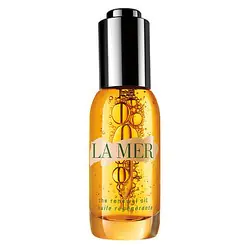
Natural cosmetics are attracting more and more attention from those who monitor the condition of their facial skin. Modern creams contain synthetic components, even if the products are natural cosmetics. Is it possible to completely switch to oils instead of creams? Which one to choose and what skin are they suitable for? In addition, questions arise about the specifics of using oils: application, frequency, course duration. Let's try to figure it out: can cream be replaced with butter?
What is the difference between the effects of creams and oils on the skin?
The main difference between cream and oil is the water content in the cream. Moisturizing facial skin is one of the important reasons why we resort to cosmetic products in the first place. Constant use of oil can lead to dryness and acne. In addition, proper nutrition of cells requires peptides, complexes of microelements that are not found in oils. So is it possible to smear your face with oil instead of cream?
Cosmetologists do not recommend completely switching to oil preparations. It makes more sense, they believe, to use both means.
Which oil to choose based on your skin type?
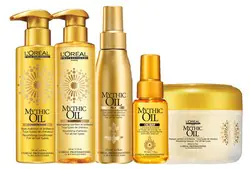
Using facial oils
All existing cosmetic oils can be divided into three main groups:
- Polyunsaturated or dry oils. Suitable for oily facial skin. Dry oils are used at night or under makeup. The most common are argan, linseed, Musket rose, borage, hazelnut, safflower, grape seed, etc.
- Saturated or non-dry oils. Suitable for dry or mixed type. These oils contain a lot of fatty acids. Avocado, macadamia, and olive oils are often used. These oils are used when pigmentation appears, to improve facial skin turgor, and at the first signs of aging.
- Semi-dry mala. Considered universal for any skin type. Ideal for massage, for the skin of the eyelids, and also for the first wrinkles. Popular oils are sesame oil, apricot kernel oil, peach oil, almond oil, juniper oil, and coconut oil for the face. They are recommended for dry skin and acne.
What are the advantages and disadvantages of oils for skin?

Cosmetologists disagree on the complete replacement of cream with cosmetic oil, but at the same time, no one denies the beneficial effects of natural oils on the skin. Opponents say that the cream contains up to 40% oil and this is enough to nourish the skin of the face. Additional components are selected according to skin types, and this fact allows you to optimize the beneficial effect of the product on the skin and achieve the desired result. Proponents of replacing cream with oil fear the harmful effects of synthetic components in the cream.
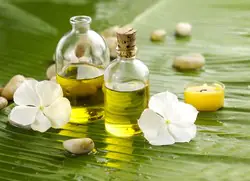
Oil in facial care
Advantages:
- Cosmetic oil is a completely natural product.
- The main effect of oils is the ability to accelerate and accelerate cell regeneration, restoring the skin from the inside.
- All oils contain organic acids, protein complexes, vitamins and antioxidants.
- The oil does not have a pronounced odor.
Pure oil is indispensable when caring for skin damaged by eczema or psoriasis, because... In these diseases, hydration is contraindicated.
Flaws:
- Oil saturated with fatty acids, when regularly applied to oily skin, clogs pores, resulting in the formation of comedones and pimples. Fatty oil is also harmful for young skin.
- Complete replacement of cream with an oil product leads to dry skin. The fact is that natural oil, penetrating the skin, disrupts fat metabolism. At the same time, the film that appears on the surface of the skin prevents the evaporation of moisture and prevents the skin from breathing. As a result, metabolic processes in cells slow down, causing dryness and dehydration of the skin.
- The oil almost completely removes natural fat from the surface of the face. As a result, the skin becomes vulnerable to temperature fluctuations and exposure to sunlight.
How to use oil correctly?
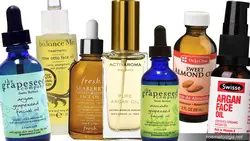
Variety of facial oils
Rules for using cosmetic oil for facial skin instead of cream:
- Nutrient formulations made from oils are used twice a week. The course lasts 1-2 months.
- The oil is applied to cleansed, moisturized skin or a few drops are dropped onto a cotton pad soaked in water and wiped over the face.
- It is better to use undiluted oil at night instead of cream.
- The best option is to add oil to face cream, thereby increasing its effect.
Oil should be added to a high-quality cream, otherwise harmful substances along with the oil will penetrate the skin. Baby cream is best suited for this.
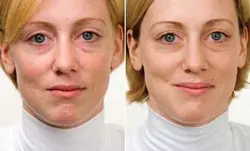
Before and after using oil
Amount of oil for different skin types:
- dry - no more than 5 drops;
- normal - no more than 3 drops;
- oily and combination - 1-3 drops.
The most affordable and popular, judging by the reviews of oil supporters, is olive oil. Cosmetics manufacturers are actively introducing it into creams. It is permissible to smear your face with olive oil instead of cream, provided that the above rules are followed.
You shouldn’t completely switch to cosmetic oils for your face instead of cream; the rule of the golden mean applies here. Reviews from supporters of moderate use of oils indicate excellent results after proper use of the oil product. It is also worth listening to the advice of cosmetologists and applying oil in accordance with your skin type, adhering to the course period.



